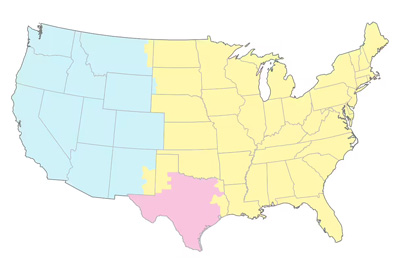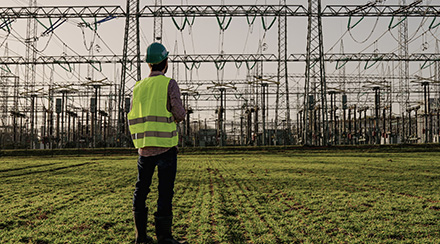What Is a Power Grid?
Have you ever wondered how electricity gets from its point of origin to the circuits in your home? Electricity is transmitted all over the U.S. through a network of components that form a power grid. Power plants, high-voltage transmission lines, substations and other elements work together like a giant machine to ensure that electricity keeps flowing to homes and buildings.
Power Grids in the U.S.

Because the continental United States is so interconnected, you might think it’s covered by one continuous electrical grid. But there are actually three power grids in the U.S.: the Eastern, Western and Texas Interconnections.
The Eastern Interconnection extends from the Rocky Mountains to the Atlantic Ocean, and includes Central and Eastern Canada. It also includes parts of Texas near the state’s northern border. The Western Interconnection extends from the Rocky Mountains to the Pacific Ocean, and includes Western Canada.
The Texas Interconnection covers most of Texas and operates entirely within state borders. The explanation for why Texas is on its own grid dates back to the early days of government regulation of utilities. President Franklin Delano Roosevelt signed the Public Utility Holding Company Act in 1935, which gave the federal government broad authority to regulate electricity generators. But because this law only applied to power companies engaging in interstate commerce, Texas’ power companies decided to avoid federal regulation by building their own exclusive electrical grid within state lines.
What Is an Electrical Grid?
You can break a power grid down into a seemingly infinite number of component parts, but there are five main components that make up the basic structure:
- Power plants. These facilities generate electricity through the use of fossil fuel generators, nuclear reactors and renewable energy technologies like wind turbines or solar panels.
- High-voltage transmission lines. These large power lines originate at power plants and carry electricity long distances at high voltage, which helps minimize energy loss.
- Substations. Many high-voltage transmission lines end at electrical substations, where the voltage is reduced (a process called “stepping down”) so that it can be transferred to lower-voltage distribution lines.
- Distribution lines. Smaller than high-voltage transmission lines, these power lines carry electricity from substations to numerous termination points, including homes, buildings and electrical transformers.
- Transformers. These devices are often installed on utility poles between substations and the homes and buildings they supply with power. Transformers have the ability to further “step down” the voltage to ensure it’s at a safe level before the electricity reaches its customers.
Threats to the Power Grid
Our interconnected power grids are among the most important infrastructure in the U.S., but they’re also vulnerable to a variety of looming threats.
The age and condition of U.S. power grid infrastructure is a major concern. According to a 2022 Reuters report, the average electrical transformer is more than 40 years old, and when the U.S. Department of Energy reviewed its energy infrastructure in 2015, it found 70 percent of U.S. transmission lines to be at least 25 years old. A typical transmission line lifespan is 50 years.
Age-worn infrastructure is particularly threatened by severe weather events that are growing more frequent and powerful due to climate change. Energy producers are trying to combat this problem in two ways: by hardening the grid with infrastructure like buried power lines and fire-resistant utility poles, and by transitioning to renewable energy as a means of slowing the rate of climate change.
The power grid is also vulnerable to cyberattacks that could result in blackouts and other problems. While there are layers of safeguards designed to thwart malicious hackers, the U.S. Government Accountability Office has recommended that the U.S. Department of Energy and Federal Energy Regulatory Commission take additional steps to create an effective national strategy against cyberattacks against the grid.
The Future of the Power Grid

As the nation’s energy workforce continues to harden the power grid and replace its aging parts, it’s also modernizing it.
One of the most noticeable changes is the proliferation of “smart meters” to replace traditional electric meters. Smart meters can communicate wirelessly with electrical utilities, reducing dependence on meter readers and in-person visits for tasks like connecting or disconnecting service. They can also give customers access to more detailed data about their energy use, which can help inform energy efficiency upgrade decisions.
Phasor Measurement Units, or PMUs, are sensors that are now being installed throughout the grid to report real-time data on the flow of electricity and allow utilities to prevent power outages before they occur. Utilities are also investing in automated feeder switches that reroute electricity around problems, automatic relays that reduce substation maintenance, and utility-scale battery systems that can help electricity generators meet peak demand.
You may not always notice the power grid infrastructure that surrounds you, but it extends just about everywhere people live and work. And with timely upgrades and emerging technology, the power grid is being prepared to meet the energy needs of the future.
Looking for Something Specific?
Select a category to find resources for topics that interest you.
Select Category

Related Articles:

How to Read Your Energy Bill
When’s the last time you really looked at your energy bill? If you ever want to know exactly where your money is going – or if you might be able to save on energy costs – you should spend a few minutes taking a deep dive into your latest energy bills.
Read Article
What’s the Difference Between Utilities and Suppliers?
In a competitive energy market, suppliers can compete with each other and often the utility for customers. Learn the differences between utilities and suppliers and the parts that both play in getting energy to your home.
Read Article
What Are the Benefits of a Retail Energy Supplier?
If you live in a state with a competitive energy market, you probably have your choice of several suppliers that are competing to win your business. Learn why signing up with one of these suppliers could benefit you.
Read ArticleMost Popular Articles

Energy Plans to Fit Your Lifestyle
NRG offers electricity and natural gas plans with perks like cash back, travel rewards and more, so you can find a plan that fits your home and family.
What Is a Power Grid?
Have you ever wondered how electricity gets from its point of origin to the circuits in your home? Electricity is transmitted all over the U.S. through a network of components that form a power grid. Power plants, high-voltage transmission lines, substations and other elements work together like a giant machine to ensure that electricity keeps flowing to homes and buildings.
Power Grids in the U.S.
Because the continental United States is so interconnected, you might think it’s covered by one continuous electrical grid. But there are actually three power grids in the U.S.: the Eastern, Western and Texas Interconnections.
The Eastern Interconnection extends from the Rocky Mountains to the Atlantic Ocean, and includes Central and Eastern Canada. It also includes parts of Texas near the state’s northern border. The Western Interconnection extends from the Rocky Mountains to the Pacific Ocean, and includes Western Canada.
The Texas Interconnection covers most of Texas and operates entirely within state borders. The explanation for why Texas is on its own grid dates back to the early days of government regulation of utilities. President Franklin Delano Roosevelt signed the Public Utility Holding Company Act in 1935, which gave the federal government broad authority to regulate electricity generators. But because this law only applied to power companies engaging in interstate commerce, Texas’ power companies decided to avoid federal regulation by building their own exclusive electrical grid within state lines.
What Is an Electrical Grid?
You can break a power grid down into a seemingly infinite number of component parts, but there are five main components that make up the basic structure:
- Power plants. These facilities generate electricity through the use of fossil fuel generators, nuclear reactors and renewable energy technologies like wind turbines or solar panels.
- High-voltage transmission lines. These large power lines originate at power plants and carry electricity long distances at high voltage, which helps minimize energy loss.
- Substations. Many high-voltage transmission lines end at electrical substations, where the voltage is reduced (a process called “stepping down”) so that it can be transferred to lower-voltage distribution lines.
- Distribution lines. Smaller than high-voltage transmission lines, these power lines carry electricity from substations to numerous termination points, including homes, buildings and electrical transformers.
- Transformers. These devices are often installed on utility poles between substations and the homes and buildings they supply with power. Transformers have the ability to further “step down” the voltage to ensure it’s at a safe level before the electricity reaches its customers.
Threats to the Power Grid
Our interconnected power grids are among the most important infrastructure in the U.S., but they’re also vulnerable to a variety of looming threats.
The age and condition of U.S. power grid infrastructure is a major concern. According to a 2022 Reuters report, the average electrical transformer is more than 40 years old, and when the U.S. Department of Energy reviewed its energy infrastructure in 2015, it found 70 percent of U.S. transmission lines to be at least 25 years old. A typical transmission line lifespan is 50 years.
Age-worn infrastructure is particularly threatened by severe weather events that are growing more frequent and powerful due to climate change. Energy producers are trying to combat this problem in two ways: by hardening the grid with infrastructure like buried power lines and fire-resistant utility poles, and by transitioning to renewable energy as a means of slowing the rate of climate change.
The power grid is also vulnerable to cyberattacks that could result in blackouts and other problems. While there are layers of safeguards designed to thwart malicious hackers, the U.S. Government Accountability Office has recommended that the U.S. Department of Energy and Federal Energy Regulatory Commission take additional steps to create an effective national strategy against cyberattacks against the grid.
The Future of the Power Grid
As the nation’s energy workforce continues to harden the power grid and replace its aging parts, it’s also modernizing it.
One of the most noticeable changes is the proliferation of “smart meters” to replace traditional electric meters. Smart meters can communicate wirelessly with electrical utilities, reducing dependence on meter readers and in-person visits for tasks like connecting or disconnecting service. They can also give customers access to more detailed data about their energy use, which can help inform energy efficiency upgrade decisions.
Phasor Measurement Units, or PMUs, are sensors that are now being installed throughout the grid to report real-time data on the flow of electricity and allow utilities to prevent power outages before they occur. Utilities are also investing in automated feeder switches that reroute electricity around problems, automatic relays that reduce substation maintenance, and utility-scale battery systems that can help electricity generators meet peak demand.
You may not always notice the power grid infrastructure that surrounds you, but it extends just about everywhere people live and work. And with timely upgrades and emerging technology, the power grid is being prepared to meet the energy needs of the future.
Looking for Something Specific?
Select a category to find resources for topics that interest you.
Select Category

Related Articles:

How to Read Your Energy Bill
When’s the last time you really looked at your energy bill? If you ever want to know exactly where your money is going – or if you might be able to save on energy costs – you should spend a few minutes taking a deep dive into your latest energy bills.
Read Article
What’s the Difference Between Utilities and Suppliers?
In a competitive energy market, suppliers can compete with each other and often the utility for customers. Learn the differences between utilities and suppliers and the parts that both play in getting energy to your home.
Read Article
What Are the Benefits of a Retail Energy Supplier?
If you live in a state with a competitive energy market, you probably have your choice of several suppliers that are competing to win your business. Learn why signing up with one of these suppliers could benefit you.
Read ArticleMost Popular Articles

Energy Plans to Fit Your Lifestyle
NRG offers electricity and natural gas plans with perks like cash back, travel rewards and more, so you can find a plan that fits your home and family.







